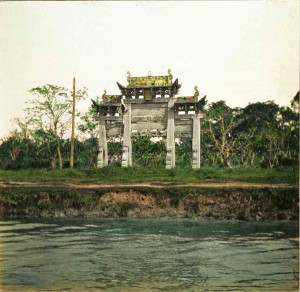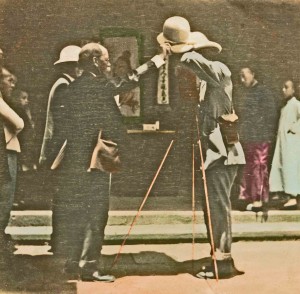Monday 2 November 2015
The first half of the flight was one big party; by the second half, everyone was asleep or half-asleep in the seats, quite exhausted. But in the beginning, many were standing in the aisles, and everybody was talking to everybody else.The attendants were relaxed and outgoing. And I met a software engineer, Hua Pin Shen, who grew up and lives in Hangzhou. As a little boy, he played on the banks of the Grand Canal, where his grandmother had her home. Coincidentally, I am looking most particularly at the history of the Grand Canal and the city of Hangzhou as it existed in 1908.
Clarence James Gamble and his older brother Sidney David Gamble travelled with their parents, David and Mary Gamble, on the Grand Canal from Shanghai to Hangzhou in 1908 and left about 110 photos from that trip. My research involves identifying the sites and individuals in the 110 photos.
Together, Hua Pin and I poured over the China 1908 photos. He told me about the monuments, the gate-like structures, very tall and wide and heavily ornamented, that Clarence and Sidney D. Gamble see as they are travelling along the Grand Canal. I learned that these monuments were built to honor women, especially women who had carried on the work of their families after their husbands had died, or who did other good works. These monuments were also erected to honour military heroes or important citizens. Pailou r牌楼 efers to those made of wood, paifang 牌楼 to those made of stone. A lengthy literature discusses them.
Four of my photos taken in China in 1908, we discovered, have the same onlooking figure in them: off to the side of the photo is a young boy, or maybe a girl, who is in the forefront, always leaning slightly into the action in the center of the photo, but usually looking at the camera. S/he is to be found in the photo where David and Sidney Gamble are setting up the camera to take the photo of the fortune teller, in the two shots of the bridal procession, and in the photo of the prisoner with the chain on his ankle.
Hua Pin and I talked about Sidney D. Gamble and Sidney’s photos and the history of China to my heart’s content. So much to learn.
The 747 landed with a good bounce (my Chinese seat mate tells me that the American pilots always come in with a hard landing, while the Chinese ease in with finesse) in Shanghai in the dark six of the evening, Shanghai time. We made our way through an entry examination of passports and documents, all quite painlessly.
And then, into the vastness of the terminal – or terminals, where I met my Japanese friend Tsutae Hamada Novick. And so we walked. New new new construction; great high halls, white marble-like walls to one side; to the other, vast sheets of glass windows; marble-like floors, white with flecks of blacks and gray; (important hard heels click and reverberate the length of the space); overhead, enormous trusses joined; and as far as the eye can see, the length of space in which to walk and walk and walk, until you reach the baggage claims or the shuttle bus pickup spot or the lined-up taxis or wherever out is.
The Chinese are robust, outgoing, noisy; they shout eat each other all the time. Apparently, it is not meant to be unfriendly. They are helpful without smiling and kind most matter of factly. There is a vigorous, loose energy that obviously can focus with pinpoint intensity. How else to explain so many software engineers, all with Masters? All the software engineers i have met have, at least, a Masters. No doubt, there is more to Shanghai than smart affluent software engineers, though probably I will not come face-to-face with the big-monied tycoons who have made Shanghai the world’s largest city.







